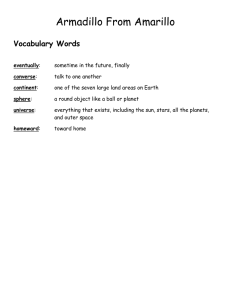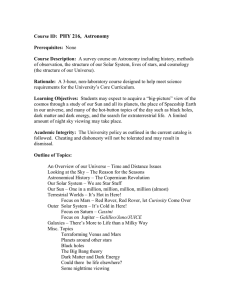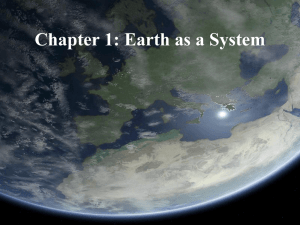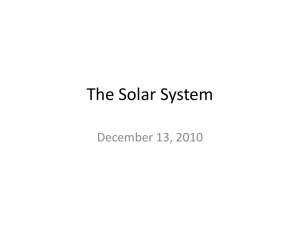The Universe is-WPS Office
advertisement
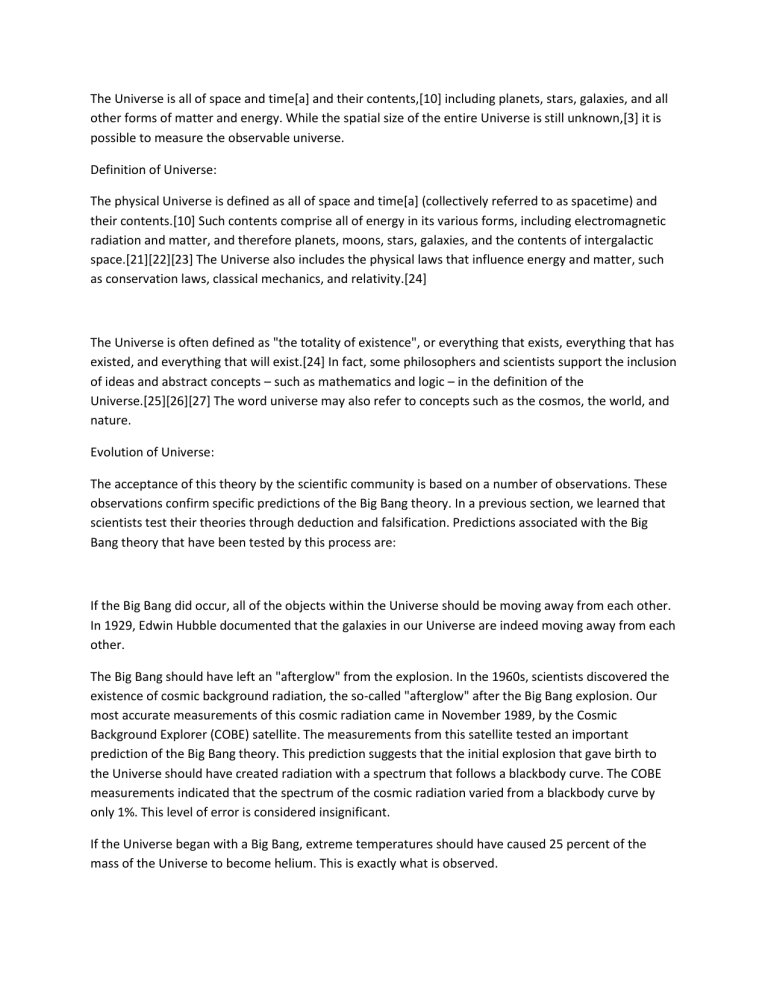
The Universe is all of space and time[a] and their contents,[10] including planets, stars, galaxies, and all other forms of matter and energy. While the spatial size of the entire Universe is still unknown,[3] it is possible to measure the observable universe. Definition of Universe: The physical Universe is defined as all of space and time[a] (collectively referred to as spacetime) and their contents.[10] Such contents comprise all of energy in its various forms, including electromagnetic radiation and matter, and therefore planets, moons, stars, galaxies, and the contents of intergalactic space.[21][22][23] The Universe also includes the physical laws that influence energy and matter, such as conservation laws, classical mechanics, and relativity.[24] The Universe is often defined as "the totality of existence", or everything that exists, everything that has existed, and everything that will exist.[24] In fact, some philosophers and scientists support the inclusion of ideas and abstract concepts – such as mathematics and logic – in the definition of the Universe.[25][26][27] The word universe may also refer to concepts such as the cosmos, the world, and nature. Evolution of Universe: The acceptance of this theory by the scientific community is based on a number of observations. These observations confirm specific predictions of the Big Bang theory. In a previous section, we learned that scientists test their theories through deduction and falsification. Predictions associated with the Big Bang theory that have been tested by this process are: If the Big Bang did occur, all of the objects within the Universe should be moving away from each other. In 1929, Edwin Hubble documented that the galaxies in our Universe are indeed moving away from each other. The Big Bang should have left an "afterglow" from the explosion. In the 1960s, scientists discovered the existence of cosmic background radiation, the so-called "afterglow" after the Big Bang explosion. Our most accurate measurements of this cosmic radiation came in November 1989, by the Cosmic Background Explorer (COBE) satellite. The measurements from this satellite tested an important prediction of the Big Bang theory. This prediction suggests that the initial explosion that gave birth to the Universe should have created radiation with a spectrum that follows a blackbody curve. The COBE measurements indicated that the spectrum of the cosmic radiation varied from a blackbody curve by only 1%. This level of error is considered insignificant. If the Universe began with a Big Bang, extreme temperatures should have caused 25 percent of the mass of the Universe to become helium. This is exactly what is observed. Matter in the Universe should be distributed homogeneously. Astronomical observations from the Hubble Space Telescope do indicate that matter in the Universe generally has a homogeneous distribution. How will the Universe End? Cosmologists have postulated two endings to the Universe. If the Universe is infinite or has no edge, it should continue to expand forever. A Universe that is finite or closed is theorized to collapse when expansion stops because of gravity. The collapse of the Universe ends when all matter and energy is compressed into the high energy, high-density state from which it began. This scenario is of course called the Big Crunch. Some theorists have suggested that the Big Crunch will produce a new Big Bang and the process of an expanding Universe will begin again. This idea is called the oscillating Universe theory. What is Solar System? A solar system is a star and all of the objects that travel around it—planets, moons, asteroids, comets and meteoroids. Most stars host their own planets, so there are likely tens of billions of other solar systems in the Milky Way galaxy alone. Solar systems can also have more than one star. These are called binary star systems if there are two stars, or multi-star systems if there are three or more stars. The solar system we call home is located in an outer spiral arm of the vast Milky Way galaxy. It consists of the Sun (our star) and everything that orbits around it. This includes the eight planets and their natural satellites (such as our moon), dwarf planets and their satellites, as well as asteroids, comets and countless particles of smaller debris. Explore Our Solar System › What is Black Whole? A black hole is a place in space where gravity pulls so much that even light can not get out. The gravity is so strong because matter has been squeezed into a tiny space. This can happen when a star is dying. Because no light can get out, people can't see black holes. They are invisible. Space telescopes with special tools can help find black holes. The special tools can see how stars that are very close to black holes act differently than other stars. What is Earth? Earth is the third planet from the Sun and the only astronomical object known to harbor life. According to radiometric dating and other sources of evidence, Earth formed over 4.5 billion years ago. Earth's gravity interacts with other objects in space, especially the Sun and the Moon, Earth's only natural satellite. What is the Earth system? Scientists increasingly view Earth as a dynamic system – a combination of interrelated, interdependent or interacting parts forming a collective whole or entity. On a macro level, the Earth system maintains its existence and functions as a whole through the interactions of its parts, called components. At a lower level or micro level, it is helpful to think of the Earth system in terms of four central components known as the subsystems – the hydrosphere, geosphere, atmosphere and biosphere. These subsystems are interconnected by processes and cycles, which, over time, intermittently store, transform and/or transfer matter and energy throughout the whole Earth system in ways that are governed by the laws of conservation of matter and energy. The energy that drives these processes comes mainly from the Sun and sometimes from energy sources within the Earth. Examples of some of these processes include evaporation, erosion, convection currents, transpiration, photosynthesis or weathering. They can occur at different rates and in different places over time. A cycle is a collection of connected, on-going processes that circulates a common component throughout a system – such cycles are continuous with no beginning or end. Examples in the Earth system include the rock cycle, the food chain, the carbon cycle, the water cycle and energy cycles. How much water is there on, in, and above the Earth? The Earth is a watery place. But just how much water exists on, in, and above our planet? About 71 percent of the Earth's surface is water-covered, and the oceans hold about 96.5 percent of all Earth's water. Water also exists in the air as water vapor, in rivers and lakes, in icecaps and glaciers, in the ground as soil moisture and in aquifers, and even in you and your dog. Water is never sitting still. Thanks to the water cycle, our planet's water supply is constantly moving from one place to another and from one form to another. Things would get pretty stale without the water cycle! Facts About Earth: Show navigation Earth Our Planets Mercury Venus Earth Mars Jupiter Saturn Uranus Neptune Pluto Planets Quiz Coloring Pages Earth You are here >> Home >> Planets >> Earth Questions About Earth Download Questions about Earth (all answers found on this page) The Earth is unlike every other planet in the Solar System in a number of different ways. It is the only planet that has an atmosphere containing 21 percent oxygen. Starts It is the only planet that has liquid water on its surface. Starts It is the only planet in the solar system that has life. StartsThe Earth is the only inner planet (Mercury, Venus, Earth and Mars) to have one large satellite, the Moon. Mars has two very tiny moons. Mercury and Venus have none. Starts The Earth is fragile. Its surface is split into plates (tectonic plates) which float on a rocky mantle – the layer between the surface of the earth, its crust, and its hot liquid core. The inside of the Earth is active and earthquakes, volcanoes and mountain building takes place along the boundaries of the tectonic plates. Starts As a result of the Earth’s geological activity (the volcanoes and earthquakes) the surface of the Earth has far fewer craters than the surface of planets such as Mars, Venus and Mercury or the surface of the Moon. The craters have sunk down or been worn away by wind and rain over millions of years. Starts When viewed from outer space much of the Earth’s surface cannot be seen because of clouds of water vapour. The water vapour makes the Earth, when seen from outside, into a brilliant shining orb, as you can see in Figure 1. The Earth Figure 1. Earth taken from the Apollo 17 spacecraft in 1972 The Earth is the third planet from the Sun and comes between the planet Venus and the planet Mars. Earth third planet from the sun Figure 2. The planets of the Solar System. The Earth takes 365¼ days to complete its orbit round the Sun. The Earth’s year is therefore 365 days long but the ¼ days are added up and every fourth year has one extra day, on the 29th of February. This fourth year is called a Leap Year (366 days) and is always a year which can be divided exactly by 4 – 2000, 2004, 2008, 2012, 2016. Starts The planets closer to the Sun, Mercury and Venus, have shorter years than the Earth. The planets further away from the Sun have longer years; Pluto takes 249 of our years to make one orbit of the Sun. Starts As the Earth orbits round the Sun it turns on its axis, rotating right round in 24 hours. The side of the Earth that faces the Sun has daytime and the side of the Earth that is turned away from the Sun has night-time. When it is daytime in Britain, it is night-time on the opposite side of the Earth in New Zealand. Starts As the Earth orbits round the Sun it tilts very slightly and so gives us the seasons. When the Earth has tilted so that the northern half of the Earth is a little away from the Sun, the northern hemisphere (meaning half of the Earth’s sphere) has winter. StartsAt this time the southern hemisphere is tilted very slightly towards the Sun and the southern hemisphere has summer. Winter in Britain means summer in New Zealand. Closer to the Equator there is much less difference between summer and winter. Starts The Earth is 93 million miles, or 150 million kilometres from the Sun. Starts We can also say that the Earth is 1 AU from the Sun. Astronomers (people who study the planets and stars) use a measurement called an Astronomical Unit, AU. Earth’s measurements are taken as the standard for this system, so Earth is 1 AU from the Sun, Venus is 0.72 AU from the Sun and Mars is 1.52 AU from the Sun. Pluto, furthest out, is 39.5 AU from the Sun. How many million miles from the Sun is Pluto? StartsThe Earth’s diameter, the distance round its middle at the Equator, is 7928 miles, or 12760 kilometres. Starts The Earth is not an exact sphere; the diameter going round the North and South Poles is slightly less than the diameter round the Equator. The Polar diameter is 7891 miles, or 12700 kilometres. (Try measuring the different diameters of an orange and you will see how they can differ). StartsThe Earth is larger than Mercury, Venus and Mars, the planets closest to it. On astronomy maps it often looks smaller than Venus because Venus is shown with a thick layer of sulphuric acid which lies 40 miles above the Starts The Earth differs from all the other planets because it has such a wide diversity of life and intelligent beings. This has only been possible because of the Earth’s atmosphere which has protected the Earth and allowed life to flourish.
